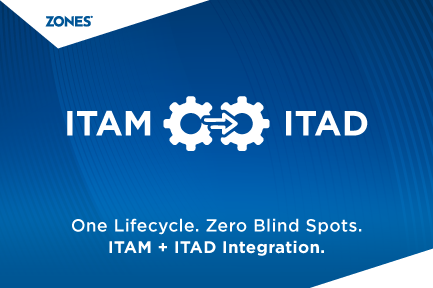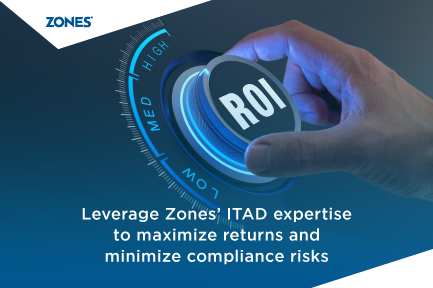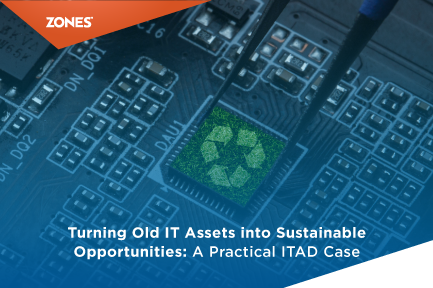How Integrated ITAM & ITAD Reduce Risk in Rollouts
When organizations roll out technology at scale whether a regional refresh, a global deployment, or a hybrid-work enablement—risk rises quickly....
5 min read
Dave Hunt & George Ganas : Oct 23, 2024 11:34:54 AM
-%26-Cybersecurity-Blog-Image.png)
Data security has never been as important as before, especially in the modern world, which instantly turns to the online sphere to solve most problems. As businesses upgrade their IT infrastructure, many overlook a crucial risk: data that may still reside on those computers that have been decommissioned. IT Asset Disposition (ITAD), safely disposing of outdated or decommissioned hardware, is important and essential aspect of security. As a result, in failure to create an effective ITAD program, companies can unintentionally risk their systems and data to breaches, great outstandingsignificant fines, and reputation loss.
This blog will outline the relationship between ITAD and cybersecurity, discuss several shared threats, and recommend state-of-the-art protection for your organization.
As we celebrate Cybersecurity Awareness Month this October, it's essential to understand the hidden risks of improperly handling retired IT assets. Many organizations focus on securing data on active devices but neglect what happens once those devices are decommissioned. According to a 2023 Verizon Data Breach Investigations Report, over 20% of all data breaches are linked to lost or improperly disposed devices.
This highlights the importance of treating ITAD as a critical component of your overall cybersecurity strategy.
IT Asset Disposal (ITAD) refers to businesses' processes and procedures to dispose of outdated or obsolete IT hardware, including hard drives, computers, mobile phones, servers, etc. Effective ITAD ensures that data stored on these devices is wiped clean, preventing unauthorized access or leaks.
Without a structured approach, companies can unknowingly put sensitive information at risk, leading to:
ITAD and cybersecurity go hand in hand. When organizations fail to follow secure ITAD practices, they expose themselves to threats compromising data security. These threats often come from gaps in the ITAD process, including:
Devices such as laptops, servers, and even smartphones often retain sensitive data even after deletion. Deleting files or formatting a hard drive does not guarantee complete data erasure. Specialized software must overwrite the data multiple times to ensure it cannot be recovered.
Many businesses mistakenly believe formatting a device is sufficient, leaving them vulnerable to data recovery techniques. Utilizing certified data erasure methods is critical for proper ITAD. You can learn more about data destruction standards from organizations like NAID (National Association for Information Destruction)
Improper tracking of IT assets during the disposition process can lead to missing devices that still contain sensitive information. These gaps make it easy for devices to fall into the wrong hands. Using a secure, auditable chain of custody ensures that every device is accounted for, from decommissioning to destruction.
Stringent regulations regarding data protection govern many industries. For example, healthcare companies must comply with HIPAA, while organizations operating in Europe must adhere to GDPR. Non-compliance can result in severe penalties. In 2020 alone, GDPR fines exceeded €150 million. An ITAD strategy that ensures regulatory compliance is critical for avoiding such penalties. Read more.
Outsourcing ITAD to third-party vendors can present additional risks if not properly managed. Organizations may be vulnerable to data breaches without clear contracts, oversight, or due diligence. Always work with certified ITAD providers to minimize third-party risk. Look for certifications such as R2 (Responsible Recycling) or e-Stewards to ensure your vendor adheres to best practices.
A robust ITAD process helps mitigate cybersecurity risks by ensuring proper disposal and data security. Here are some best practices for securing your IT assets:
Ensure that all data from retired IT assets is irretrievably destroyed. This involves using data destruction methods such as physically shredding hard drives or employing software-based data wiping tools that meet NIST 800-88standards. Certified data destruction should be documented with detailed records for future audits and regulatory compliance purposes. By choosing certified ITAD vendors, businesses can ensure data destruction is handled according to best practices.
Transporting retired assets poses a security risk if the chain of custody is not managed correctly. Ensure your ITAD partner provides a secure, trackable transportation service to minimize exposure during transit. Using GPS-tracked transportation can help monitor assets as they move from decommissioning sites to recycling or destruction facilities.
Regulations such as GDPR, HIPAA, CCPA, and others mandate the secure handling and destruction of data. Implement ITAD processes that fully comply with these laws, ensuring you avoid hefty fines. Non-compliance with regulations like GDPR can lead to penalties of up to 4% of a company’s global revenue.
An ITAD process is only as robust as its audit and reporting capabilities. Ensure that each phase of the ITAD process, from decommissioning to data destruction, is documented in real-time with clear audit trails. This allows for comprehensive reporting and internal or external audits, demonstrating compliance and accountability.
A well-structured ITAD program isn’t just good for cybersecurity—it’s also financially and environmentally responsible. Here’s how:
Data breaches are costly. According to a 2024 Report, the average cost of a data breach is $4.45 million. A strong ITAD strategy helps reduce this risk by ensuring that old assets are securely disposed of, eliminating potential vulnerabilities before they can be exploited.
Incorporating sustainability into ITAD helps reduce electronic waste. Companies protect the environment and demonstrate corporate responsibility by recycling or refurbishing decommissioned devices. This resonates well with environmentally conscious consumers and can improve a company’s public image.
Many organizations have successfully integrated ITAD into their cybersecurity strategies to prevent costly data breaches. One notable case is a global healthcare provider implementing a certified ITAD process for outdated medical devices. By partnering with a certified ITAD vendor, the company ensured that all data was securely wiped and recycled in compliance with HIPAA and GDPR.
This proactive approach protected patient data and saved the company millions in potential fines and breach recovery costs.
As technology continues to evolve, so do the risks associated with data security. Businesses must recognize the critical role that IT Asset Disposition (ITAD) plays in their cybersecurity strategy. Proper disposal of retired IT assets reduces the risk of data breaches, ensures regulatory compliance, and protects the company’s reputation.
This Cybersecurity Awareness Month, take the opportunity to assess your ITAD practices. Is your data secure when it leaves your devices? If not, it’s time to adopt a comprehensive ITAD program that safeguards your data from start to finish.
Secure your IT assets today—because prevention is always better than cure in cybersecurity.
With our expertise in e-waste disposal and data destruction, decades of operational excellence, partnerships with EPA-compliant recyclers, and customized solutions, Zones offers full compliance and peace of mind.
So, let us take care of your ITAD needs and experience a smooth and sustainable transition for your technology assets.
In today's digital landscape, the importance of a robust IT Asset Disposition (ITAD) strategy cannot be overstated. As businesses increasingly rely on technology, the risks associated with improperly handling decommissioned IT assets grow significantly. By prioritizing secure data destruction, maintaining a clear chain of custody, and ensuring compliance with regulations, organizations can protect sensitive information and mitigate potential threats.
This Cybersecurity Awareness Month, take proactive steps to evaluate and strengthen your ITAD practices. The security of your data is an ongoing responsibility, and a comprehensive ITAD program is a vital component of your overall cybersecurity strategy. By safeguarding your retired assets, you not only protect your organization from breaches and penalties but also contribute to a more sustainable future through responsible e-waste management.
Embrace the challenge of securing your data—because in the realm of cybersecurity, it’s always better to be prepared than to react. Let us help you navigate the complexities of ITAD and ensure your organization’s data remains safe and secure.

When organizations roll out technology at scale whether a regional refresh, a global deployment, or a hybrid-work enablement—risk rises quickly....

How Zones’ ITAD Services Maximize ROI and Minimize Risk As technology cycles accelerate and data security stakes rise, businesses are rethinking how...

To stay in the market, organizations constantly work towards enhancing their technology as it is required in the current era. This comes with a...